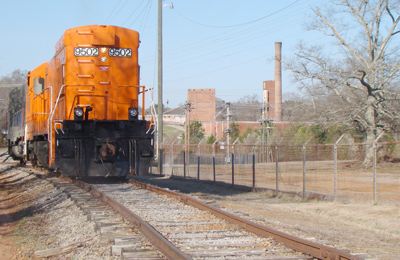Last train out

After more than 100 years, Pickens
Railway makes final trip to Easley
By Nicole Daughhetee
Courier Staff
PICKENS — At 9 a.m. on Tuesday, April 2, Pickens engine 9502 pulling locomotive CLCX 12132 of the Pickens “Doodle” Railway made its final journey from Pickens to Easley.
Although its glory days are long forgotten, the railroad is a vital thread interwoven into the rich fabric of Pickens history.
Donnie Sims, General Manager of the Pickens Railway Company (PICK) with 36 years of experience with the company under his belt, said though the company is still alive and well in Anderson, Pickens would not be what it is today without the railroad.
“People don’t realize it, but the railroad built Pickens,” Sims said. “The town was here before the railroad, no doubt, or else the railroad wouldn’t have been coming, but it was a major catalyst in freight coming into this town.”
The Pickens Railroad was a short-line railroad that operated in the Upstate for more than a century, beginning in the 1890s. Chartered in 1890 to build a 19-mile line from Easley to Oolenoy Gap, by way of Pickens, the 8.5 mile stretch of rail between Pickens and Easley opened in 1898. Two prior attempts at construction of the rail line had failed due to lack of investor interest.
At Easley, the Pickens Railway connected with the Atlanta & Charlotte Air Line Railroad, a system which would become part of the massive Southern Railway. The route would actually become part of the Southern’s Atlanta to Columbus, Miss., corridor.
On its very first revenue run to Easley in 1898, the train derailed. Legend has it that several local children placed spikes on top of the rails to see if anything would actually happen to the train.
The train became known as the Doodle because there was no way to turn the engine between runs on the eight-mile route, and it returned to Pickens backward, looking like a doodle bug.
“I heard guys talk about A-models coming in on the train, and they would put them together right in front of the depot and take them to the Ford dealership,” Sims said. “A car would come in and it would have all kinds of stuff in it. It might be a pallet of flour or rolls of cloth for ladies’ dresses.
“Railroading today is totally different than what it was then. It used to be a railcar would travel to a big depot, like Greenville, and when they got that car pretty full it would come to Pickens, just like UPS today.”
Initially the railroad had three freight cars, one passenger car and one steam locomotive, a 4-4-0 named No. 1, built by Danforth in 1879. In 1919, PICK acquired a new 2-6-0 steam locomotive built by Baldwin (also referred to as No. 1), that replaced the Danforth No. 1. In 1945, PICK purchased a Baldwin diesel locomotive, a VO-660 that became No. 2. It replaced steam locomotive No. 1, which was scrapped in 1956.
When PICK began operations, the company was in a precarious financial situation and did not become truly profitable until sometime in 1905. Briefly taken over by the Southern Railway in 1910, it returned to private ownership in the 1920s, when it was purchased by the Appalachian Lumber Company in 1927.
Ownership of the railroad changed hands several times through its history, belonging to George A. Hume in 1929, Poinsett Lumber and Manufacturing Company in 1939, James F. Jones in 1963, Golden Tye Corporation in 1968 and the National Railway Utilization Company (NRUC) in 1973.
Paramount for PICK was the opportunity presented by the Singer Manufacturing Company in 1939 to ship product for the sewing giant. Singer built a large plant near Pickens in the early 1920s. Over the years, the company used the railroad increasingly to ship its finished products, as well as receive materials.
In 1959, Singer consolidated its sawmill and cabinet operations with the woodworking operations from Arkansas and the Craftsman power tools from New Jersey to the Pickens location. In 1963, Poinsett announced that the Pickens Railroad was for sale, and Jones, of North Carolina, purchased the line for approximately $50,000.
Jones built a new engine house and established a car shop for rebuilding and renovating railroad cars. Jones sold the Pickens in 1973 to Philadelphia-based NRUC, which expanded the car shop to build new freight cars.
The NRUC built a fleet of boxcars and put them on the PICK line in addition to several other railways like the Virginia Central Railway. Eventually NRUC managed approximately 8,000 boxcars — 1,000 of which belonged to PICK.
After owning the company for 23 years, the NRUC sold it to the CLC-Chattahoochee Locomotive Corporation in the spring of 1996, which renamed the line as the Pickens Railway. The short-line gained its additional 30 miles of track when, in the early 1990s, Norfolk Southern leased its branch between Anderson, Belton and Honea Path.
Today, under the ownership of Chip and Nancy Johnson, the Pickens continues to serve the same cities it did more than 100 years ago with a traffic base consisting of kaolin, limestone, synthetic rubber, rubber processing oil, plastics, silica, scrap metal, paper, scrap paper, bird feed ingredients, farm supplies and electrical equipment.
“We’re not dying,” Sims said. “But Tuesday was the last trip one of our trains will ever make between Pickens and Easley.”
The growth and evolution of Pickens has seen the end of an era for textile mills and the manufacturing plants that were once the bread and butter of Pickens. Because PICK primarily serviced these industries by hauling in raw materials and hauling out finished products, without the mills and manufacturing, the railway in Pickens has become obsolete.
“PICK is what built the town of Pickens,” said Sims. “We served all the Alice Manufacturing plants, and local sawmill and concrete plant. For the last 11 years we’ve had no freight revenue because the mills all shut down.”
The actual track running from Pickens to Easley, succumbing to wear, weather and age, is in fairly poor shape. While PICK has moved its operations to Anderson, the important role the Pickens Railroad served in the growth and development of the city of Pickens will never be forgotten.
While the railroad might no longer exist to haul freight to the textile mills, it isn’t without purpose. There has been a great deal of buzz around talks that the Doodle Line will be converted into recreational walking and biking trails as part of the National Rails to Trails Project, which not only breathes new life into the old rails but helps preserve the vital piece of history upon which Pickens was founded.























